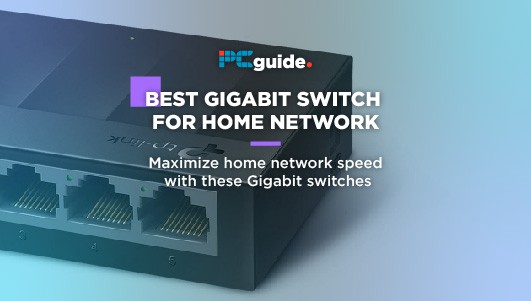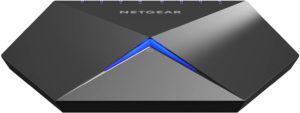Best Gigabit Switch For Home Network in 2023

Table of Contents
In recent years, the general consensus has become that everything should be wireless. Charging, data transfers, and especially internet connectivity are all leaning towards wireless technology. Wi-Fi, Bluetooth, AirDrop, and more complete our day-to-day tasks. This is all well and good in a perfect environment. However several variables can affect the speed of these services, especially Wi-Fi. From other wireless signals to a fish tank, Wi-Fi can provide variating results.
Ethernet connections are still the go-to internet solutions for homes and businesses worldwide. They provide fast connectivity without the usual variables that can affect wireless signals. So you want to connect your devices via ethernet? Great choice, but most routers only have a handful of ethernet ports, and more often than not, routers are normally situated in the most awkward spot in homes and offices. Enter the gigabit switch for home network.
Products at a Glance
What is a Gigabit Switch?
Think of a gigabit switch as a mains plug extension for the ethernet ports at the back of your router. Not only can users maximize the ports available, but they can also situate the gigabit switch at a more convenient location in their properties for easy access. Most offices do this when managing their networks.
Gigabit switches come with various numbers of ports, it’s probably a good idea to check how many you’ll need before making a purchase. There are also different types of switches that provide different services:
- KVM Switch: Used to manage multiple PCs from a single unit. This is more for large-scale companies that use this kind of switch to maintain server rooms. It can also be used by home users for various uses. For example, sharing a display between a desktop and Xbox.
- Managed Switch: These types of switches allow users to manage network traffic coming in and out of it. This is where QoS comes into play, allowing users to prioritize bandwidth and traffic based on a connected device’s needs. For example, an online gamer would need more bandwidth than a PC used for day-to-day office work.
- Unmanaged Switch: Normally the cheapest option used to simply connect all Ethernet-based devices into one router. This is normally the best solution for someone not interested in managing their network traffic.
- Smart Switch: Sitting somewhere between a beginner and managed gigabit switch, the smart switch provides set, easy-to-understand guidelines that allows it to self-manage traffic.
- PoE Switch: This gigabit switch provides power to the connected ethernet device so it doesn’t need an ac adaptor to function. This is normally used for security equipment.
Which Switch Should I Pick?
We’ve picked out five best gigabit switches for home networks that we feel are relevant and suit home and small office users. We’ve picked the best switches for each type listed above which cover just about everything you’ll need in your home.
How did we pick?
We looked at the strength of connection and general performance compared to the price, as our main factor when deciding which gigabit switches were best. Special features such as link aggregation and temperature control were also considered when weighing up which model would be best for specific needs.
How we tested
We’re avid PC fans here at PC Guide. Rest assured we know our stuff when it comes to testing tech like these gigabit switches. We’ve scoured the web to find the best expert opinions on these various pieces of kit, alongside our own team’s knowledge.
Product Reviews
- Great build Quality
- Built in QoS
- Router QoS overrides Switch QoS
There’s an element of snake oil when it comes to QoS running on a gigabit switch for home network. If your router doesn’t support it, then great, but if it does, data gets a big QoS tag from the router first. It renders the QoS down the line on the gigabit switch useless, the Netgear Nighthawk s8000 is a great example of this. It’s not so much a mis-sell, more of a strange feature trying to solve an issue that technically doesn’t exist.
Its smart features do shine through for streamers and gamers, with gaming, streaming, and uplink taking up the first three ports by default. The link aggregation feature is also very cool, allowing two ethernet ports to be linked to provide double the bandwidth. Whilst this takes up ports fast, it’s perfect for small gaming/streaming households.
Long story short, S8000 is targeted at gamers who have an outdated router or run a mesh network with no QoS. It has some great features for newcomers to the gaming gigabit switch world, but it’s hardly worth upgrading if you have a solid setup already.
- Plug and Play
- Great Build
- Lacking network management options
Unmanaged switches are great for users just wanting more ethernet ports to plug into for moderate bandwidth use. For example, a small family or single person using a couple of devices at a time probably wouldn’t benefit much from a managed switch.
Featuring 8-ports and a robust design, there’s more than enough room for home networks. TL-SG108 can also be daisy-chained if needed, although it would be wise to employ some kind of network management at the router level to ensure devices are getting the right amount of bandwidth and also not clogging up your network.
Rocking 1000Mbps auto-sensing ethernet ports, the TP-SG108 is ready to go straight out of the box, making this product one of the easiest pieces of network tech to set up for all kinds of users.
- Plug and Play
- Easily Mountable
- Cheaper alternatives available is PoE isn't needed
If you don’t have any PoE devices, there’s not much point in having this unmanaged device. However, the POE-SW802G is perfect for running security camera arrays, Raspberry Pis, and wireless access points. Most of this tech is managed by its own software or hardware, so it’s no big deal that the POE-SW802G is unmanaged.
It’s very much a plug-and-play gigabit switch for home network, which takes one headache out of running PoE systems. It’s probably a good idea to check how many ethernet ports you’ll need for your PoE equipment, but this PoE switch has 8 PoE ports which should be more than enough for even the most robust security setups.
Another great feature is great temperature control. There are various statements of POE-SW802G standing the tests of time in freezing and warm environments. From outhouses to attic spaces, this piece of kit is also easily mountable to adapt to your home security setup.
- Multitasking between work and personal computers made easy
- Save space on multiple monitors
- No Networking functionality
There are plenty of Gigabit-enabled KVM switches on the market, but they seem to have fewer features as a result. For example, the MT-VIKI displays 4k @ 30FPS compared to a KVM 1440p @ 30FPS switch for triple the price point. We would recommend keeping your networking solution separate and using a device like this when managing multiple displays and PCs.
MT-VIKI KVM switch allows users to control up to four PCs through one monitor, it’s a great solution for home workers, IT technicians, and more on a budget. It’s a plug-and-play piece of kit, which means no drivers and software to configure. Other KVM switches allow for multiple peripherals to be used across multiple devices, this KVM switch has 3 USB 2.0 ports on it and does just that. Saving users the hassle of having multiple keyboards and mice and minimizing desktop footprints.
- Amazing for power users looking to get the best out on their network
- 24 ports to handle bigger home networks
- May prove complicated for beginners
At first glance, you’d be forgiven for thinking Mikrotik CSS326 has come straight from a server room. It’s a heavy duty bit of kit that gives users almost every kind of option possible for a managed gigabit switch. I’m not going to go into the exact details and overload with jargon here, but we will tell you why we recommended this unit in particular.
Firstly, managed switches are usually for high-end users looking to tweak network performance for big networks. If you happen to be running multiple media servers or have a metric tonne of ethernet enabled devices at home, this may be a wise choice given it’s 24 gigabit ethernet ports.
Best of all, it comes with SwOS, MikroTik’s switch operating system. Whilst it’s not the latest version, it gives users plenty of options when it comes to managing their home network. This can be accessed via web browser.
PC Guide Expert Opinion
The verdict on this one is mixed – it ultimately depends on what you need the connection for. If you
What does latency mean?
It means the delay before a transfer of data begins following an instruction for its transfer. For example, gamers need as little latency as possible when playing games online for a competitive edge.
What does auto negotiation do?
Auto-negotiation allows a gigabit switch port to communicate with the device on the other end of the link to determine the best speed for said connection.
QoS?
Standing for Quality of Service, QoS makes sure traffic in a network is assigned the correct amount of bandwidth based on connection speeds.
What is IGMP Snooping?
IGMP snooping identifies multicast groups, which are groups of computers or devices that all receive the same network connection. It then forwards packets to the correct network devices.
What does SFP Unlink stand for?
‘Small Form-Factor Pluggable’ – It links giga switches and routers to your home network.
Our Verdict
The discussion of the best giga switch is a very subjective one that depends on what you need the switch for. If you need power to go to connected ethernet devices, a standard unmanaged switch isn’t going to help you. With that being said, our favourite of the three is TP-Link TL-SG108. It does everything it needs to do for most home networks with a very reasonable price tag to boot.




